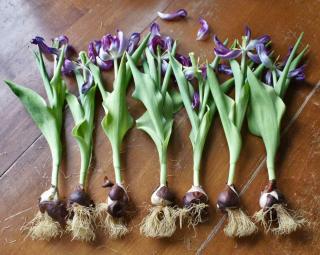

Choosing the right bulb for the tulip plant has been, for some, a quest dating back centuries. The aim? Getting that elusive colorful and abundant blooming!
True tulip bulb key facts
Botanical name – Tulipa
Family – Liliaceae
Type – flower bulb, true bulb
Planting – September to October
Soil – light, sandy, draining, rich
Planting distance – 4 to 8 inches (10 to 20 cm)
Planting depth – 4 to 6 inches (10 to 15 cm)
Exposure – full sun, part sun
A tulip bulb, once planted, will grow to bear fabulous flowers. Colors might be bright or subtle, depending on the variety, and when spring arrives they all enchant gardens, balconies, terraces and even the indoors of homes. Early varieties, or late ones? Botanical species or cultivated ones? To date, over 5000 tulip bulb varieties exist for us to plant in our autumn gardens. The ones you’ll find in garden stores usually come from the sandy plains of Holland.

Its typical shape is formed by the swollen base of each leaf. At the center, you’ll find the main bud together with floral buds. To the side, you can uncover lateral buds: these will produce bulblets later on. A special, thin peel covers the bulb. It’s brown and dry, and it’s duty is to lock water inside the bulb to survive through drought. The tulip bulb also has central scales that grow above ground, forming true chlorophyll-filled leaves. During the blooming phase, the bulb consumes its nutrient reserves to feed the bloom. As a consequence, the thicker the tulip bulb, the higher the chance of getting a large flower.
Appearance and caliber (or size) are the two criteria that will help you choose the right kinds of tulip bulbs.
First of all, the tulip bulb must feel firm. If it feels soft, discard it. Check that it isn’t infected with mold. To find out, squeeze the bulb in your hand before choosing it.
Noteworthy information: don’t worry if the bulb has lost its thin skin. Even though it doesn’t look complete, this won’t influence the outcome.
The largest bulbs have gathered more nutrients than smaller ones. This alone will significantly impact the blooming, even if the weather doesn’t play along.
To keep them from molding, bulbs must be planted quickly after having been purchased. If ever you’ve got to keep them for a long time before planting them, it’s best to store them in a cellar or cool, dry garage. Remove them from their packaging and wrappers.
In autumn, between September and October, plant tulip bulbs before the first frosts hit. This will give your tulip the time it needs to grow and spread its roots. Best find for it a sunny spot, or at least partly sunny, without any wind.
To learn more, read:
If you plant tulip bulbs in places of your garden that get different sun exposure, you’ll have staged blooming during spring. It can span a month if you plant from full sun to shade.